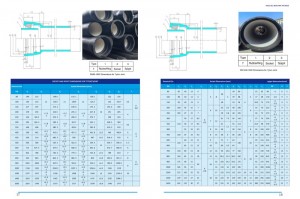The European Standard EN545 and EN598 govern the dimensions and thicknesses ofductile iron pipes for water and waste water applications, respectively:
- Diameter: EN standards cover a wide range of nominal diameters, from DN80 to DN1600.
- Wall Thickness: Unlike the AWWA standards, EN standards provide specific wall thicknesses for each diameter and class of pipe. The wall thickness is determined based on the pipe’s nominal diameter and its class designation, which corresponds to the pipe’s designed operating pressure and application environment.
- Class Designation: EN 545 and EN 598 classify pipes by their allowable operating pressures and application environments. (e.g., C40 for 40 bars).

Both American and European specifications ensure that DIPs are suitable for thelr intended applications, providing essential guidelines for manufacturers and engineers in designing and selecting piping systems. it’s important to consult the latest editions of these standards, as updates and revisions may affect the specifications. Additionally, the choice between American and European standards often depends on regional preferences, project specifications, and local regulatory requirements.
K7, K9 CLASSES (EN 545)
The designations K7, K9, etc refer to different classes of ductile iron pipes defined primarily by their wall thickness and hence their strength and pressure-handling capabilities, This classification system is widely used in international standards, including ISO 2531 and EN 545, which are commonly referenced for water supply and sewage applications.These classes are part of the standardlized system used to categorize ductile iron pipes based on their nominal wall thicknesswhich directly correlates with the pipe’s ability to withstand internal pressure.
K Classes
- K Class Number: The “K” value in these desianations indicates the class of the pipe, with the number following “K”representing a specific ratio related to the wall thickness. Essentially, the higher the “K” number, the thicker the wall of the pipe and, consequently, the higher its ability to handle pressure.
- Pressure Capacity: While the “K” class does not directly specify the pressure rating in bars or psi, it implies a pipe’sdurability and strength due to the wall thickness. For instance, K9 pipes are thicker and stronger than K7 pipes, making them suitable for higher-pressure applications.
- Calculation: The wall thickness for a given “K” class can be calculated based on the pipe’s internal diameter and thespecific “K” value, using formulas provided in the ls0 2531 and EN 545 standards. This calculation ensures that pipes havesufficient strength to handle the expected internal pressures plus a margin for safety.
Common Classes And Applications
- K7: Often used in applications where lower pressures are anticipated or where ground conditions are stable and present minimal risk to the pipe.
- K9: This is the standard class for a wide range of applications, including municipal water supply and distribution networks.It offers a balanced combination ofstrength and cost-effectiveness
- K10 and Above: “hese classes are selected for conditions reauiina hicher pressure hondlina orwhere externo oads on the pipe are greater, such as in areas with heavy traffic overhead or unstable ground.

Selection Criteria
- Choosing the appropriate “K” class for ductile iron pipes involves considering the operational pressure, the type of fluid being transported, the burial depth of the pipe, soil conditions, and external loads, Engineers also factor in safety, longevity, and compliance with local and international standards when selecting the pipe class.
- The “k” classification system provides a standardized approach to specifying the wall thickness and, by extension, the strength and pressure capacity ot ductle lron plpes. By selecting the appropriate “k” class, engineers can ensure that piping systems areadequately designed to meet the demands of ther intended applications, combining durability with cost efficiency.
Differences Between C-Class And K-Class In EN545
The classifications of ductile iron pipes using “C” and “K” values, such as C30, C40, K7, and K9, refer to different standards for defining the pipe’s strength, thickness, and pressure capabilities, primarily within the framework of EN545, which is a European standard for ductile iron pipes, ductile iron pipe fittings, accessories, and RJ joints, push on joints for water pipelines.
The “c” classification system specifies the pipe’s nominal pressure class. The number following “C” represents the nominal pressure in bars that the pipe can withstand. Forinstance:
This system directly relates to the pipe’s ability to withstand internal pressures, and it is a straight forward indication of the pipe’s pressure rating. The higher number, the greater the pressure the pipe can handle, this classification is more directly concerned with the operational pressures within the pipes.
The “K” classification, on the other hand, is related to the pipe’s wall thickness and indirectly to its pressure capacity. The “K value is a coefficient used in a formula that determines the wall thickness of the pipe based on its diameter. The formula takes into account the internal pressure, the diameter ofthe pipe, and the “K” value to calculate the required wall thicknessfor standard laying conditions. For example:
- K7: A specific “K” class indicating a certain wall thickness ratio, designed for standard pressure applications
- K9: Typically the standard class for many applications, offering a thicker wall and, hence, capable of withstandinghigher internal pressures and external loads compared to K9
Key Differences and Applications
- Direct vs. indirect Pressure indication: The “C” classification directly indicates the pressure rating of the pipe in bars making it straight forward to determine the pipe’s suitability for specific pressure conditions. The “K” classificationindirectly indicates pressure capacity by defining the wall thickness, which correlates with the pipe’s ability to handle both internal pressures and external loads.
- Design Focus: The “C” class is focused on the pipe’s pressure endurance, while the “K” class emphasizes the structural design and thickness, influencing both pressure endurance and physical robustness against external forces.
- Usage: Selection between “C” and “K” classifications will depend on engineering requirements, specific application needs, and local or project-specific standards. The “K” class is often used in specifications for general water supply. where as the “C”class may be specified when direct pressure requirements are a priority.
Pipe Lengths (EN 545)
European standards, such as EN 545 (for water pipelines) and EN 598 (for sewerage applications, define the lengths ofductile iron pipes as follows:
- Standard Lengths: In Europe, the standard lengths for ductile iron pipes are commonly 6 meters (about 19.7 feet, witha tolerance that can vary slightly dependina on the manufacturer’s specifications.
- Short Lengths: For special applications, including fittings and adjustments to the pipeline route, shorter lengths arealso available, typically ranging from 1 meter (about 3.3 feet) to 3 meters (about 9.8 feet).
Post time: Jun-16-2025










